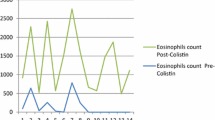Abstract
Treatment efficacy with netilmicin sulphate/methylprednisolone sodium succinate in a severe septic shock baboon model, using an LD100 of liveEscherichia coli, was evaluated. All the animals treated with both netilmicin and methylprednisolone were premanent (≥ 7 days) survivors, whereas none of the untreated baboons lived more than 24 hours. These results indicate that, in a baboon model, netilmicin is an effective alternative to gentamicin (with methylprednisolone) in the treatment of severe septic shock.
Similar content being viewed by others
References
Beller BK, Archer LT, Passay RB, Flournoy DJ, Hinshaw LB (1983) Effectiveness of modified steroid-antibiotic therapies for lethal sepsis in the dog. Arch Surg 118:1293–1299
Carbon C, Contropois A, Lamotte-Barrillon S (1978) Comparative distribution of gentamicin, tobramycin, sisomicin, netilmicin, and amikacin in interstitial fluid in rabbits. Antimicrob Agents Chemother 13:368–372
Cronin RE, Bulger RE, Southern P, Henrick WL (1980) Natural history of aminoglycoside nephrotoxicity in the dog. J Lab Clin Med 95:463–474
Engle JE, Abt AB, Schneck DW, Schoolwerth AC (1979) Netilmicin and tobramycin, comparison of nephrotoxicity in dogs. Invest Urol 17:98–102
Haverkorn MJ (1983) Netilmicin 150 mg every 12 hours in systemic infections. J Antimicrob Chemother 12:209–217
Herting RL, Lorber RR, Miller M, Danzig MR (1981) Multicenter comparative evaluation of netilmicin and gantamicin in adult patients. Arzneim-Forsch/Drug Res 31:366–370
Hinshaw LB, Archer LT, Beller-Todd BK, Coalson JJ, Flournoy DJ, Passey R, Benjamin B, White GL (1980) Survival of primates in LD100 septic shock following steroid/antibiotic therapy. J Surg Res 28:151–170
Hinshaw LB, Beller BK, Archer LT, Flournoy DJ, White GL, Phillips RW (1979) Recovery from lethalEscberichia coli shock in dogs. Surg, Gynecol & Obstet 149:545–553
Igarashi M, Levy JK, Jerger J (1978) Comparative toxicity of netilmicin and gentamicin in squirrel monkeys (Saimiri sciureus). J Infect Dis 137:476–480
Luft FC, Bloch R, Sloan RS, Yum MN, Costello R, Maxwell DR (1978) Comparative nephrotoxicity of aminoglycoside antibiotics in rats. J Infect Dis 138:541–545
Luft FC (1978) Netilmicin: a review of toxicity in laboratory animals. J Int Med Res 6:286–299
Martinetto P, Valtz A, Pessione E, Curino E, Olivero S (1982) Studies on the kinetics of netilmicin in human serum and tissues. Drugs Exptl Clin Res 8:129–135
Perera MR (1982) High-dose netilmicin in patients with life threatening sepsis. J Antimicrob Chemother 9:231–237
Author information
Authors and Affiliations
Rights and permissions
About this article
Cite this article
Flournoy, D.J., Archer, L.T., Beller, B.K. et al. Treatment of LD100 Escherichia coli septic shock with netilmicin and methylprednisolone in baboons. Med Microbiol Immunol 175, 221–227 (1986). https://doi.org/10.1007/BF02123730
Received:
Issue Date:
DOI: https://doi.org/10.1007/BF02123730



